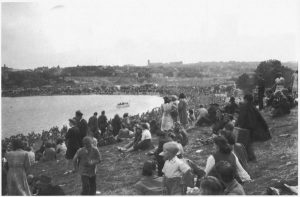
Photo Credit: The Rooms Provincial Archives Division: A54-150; Crowds at Quidi Vidi Lake for the Royal St. John’s Regatta.
ARCHIVAL MOMENT
August 6, 2019
ROYAL REGATTA ROULETTE
The Royal St. John’s Regatta is the only civic holiday in Canada that is dependent on the weather. “The Regatta” has been traditionally held on the first Wednesday in August.
On the night before the Regatta the residents of the historic city have the option to stay at home and have a quite night or “roll the dice” and party!! The choice has become known as “Regatta Roulette.”
As residents party into the night, refreshment (s) in hand, there is always the lingering question, when I turn on the radio at 5:00 a.m. will the Royal Regatta officials say “IT IS A GO” or will it be a day at work?
An estimated 35,000 -50,000 people go to lake side at Quidi Vidi Lake, St. John’s to enjoy the races and the concessions.
“… A ROWING MATCH WILL TAKE PLACE …”
The first documentation of boat races in St. John’s is taken from a very small notice in The Royal Gazette newspaper dated 1816:
“We understand a rowing Match will take place on Monday next between two boats, upon which considerable Bets are depending. They are to start at half past One o’clock from along side the Prison Ship.”
– The Royal Gazette, 6 August 1816
While this is not considered the official starting date of the Regatta, it does lend itself to the history, showing that boat racing did occur. The date the Royal St. John’s Regatta Committee refers to as the official start date is 1818.
Since that time the Regatta has become a staple of Newfoundland history, and has run continuously every year since, with few exceptions. The Royal St. John’s Regatta itself is a curious entity. It is:
- the only civic holiday in North Americato be declared by a committee of persons not associated with a government body;
- the only civic holiday that is dependant on the weather;
- the only competition where teams have to round buoys and return to the start line in order to finish the race;
- one of only four organizations in Newfoundland and Labrador to be granted the Royal Designation (the others are The Royal Newfoundland Regiment, The Royal Newfoundland Constabulary and The Royal Newfoundland Yacht Club).
Will we get together for a drink (tonight) Tuesday night? Will it be a quite night at home? Regatta Roulette!
Recommended Archival Collection: At the Rooms Provincial Archives Division take some time to look at “The Rowing” Series which consists of 212 b&w photographs predominantly of the Royal St. John’s Regatta races and crews, The photographs include team portraits, races underway, presentation of awards and views of the people along the shore of Quidi Vidi Lake. Search the Archives: http://gencat1.eloquent-systems.com/webcat/request/DoMenuRequest?SystemName=The+Rooms+Public&UserName=wa+public&Password=&TemplateProcessID=6000_3355&bCachable=1&MenuName=The+Rooms+Archives




